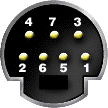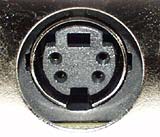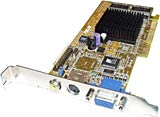
AOpen PA256Pro GeForce2 GTS graphics card
Review date: 27 July 2000.Last modified 03-Dec-2011.
Want a GeForce2 GTS graphics card? 'Course you do. It's the king of the PC 3D boards, baby.
ATI's almost-available Radeon chipset is the only thing that can beat a GeForce2 card for speed, but it's not a stand-out winner, and cards based on it aren't out yet. So if maximum 3D performance for pro graphics applications or, more realistically, games, is what you're after, then a GeForce2 is what you want.
Now, all GeForce2 GTS cards are much the same. Some have TV output as well as the plain VGA connector, some have fancy features like 3D glasses connectors, but all have the same basic graphics performance.
If you're into overclocking - running the hardware faster than its standard speed - then there'll be slight differences. Some cards may be able to run a little quicker. But, as was the case with the earlier GeForce 256 cards, the difference between the most overclockable and least overclockable GeForce2s isn't enough to get bothered about.
So if you're not especially interested in bells and whistles, you ought to just buy based on price.
And if price is your primary consideration, say hello to the best GeForce2 you can get in Australia at the moment.
The AOpen PA256Pro costs $AU632.50 including GST, the same as the base model ASUS AGP-V7700 (reviewed here). But the AOpen board's got a video output, and the ASUS doesn't.
Fancier GeForce2 cards, like ASUS' AGP-V7700 Deluxe with video in and out and 3D glasses included, sell for more than $AU700. Other basic cards with just a video out, like Leadtek's WinFast GeForce2 GTS (reviewed here) still cost the thick end of $AU700. Versions with 64 megabytes of video memory can set you back more than $AU900.
So the PA256Pro may not be an amazing ultra-bargain, but it'd still be well priced, even if it were a completely plain vanilla single-VGA-output board.
What you get
Along with the video card itself, you get four CDs. One's the Windows driver disc, containing AOpen's perfectly-all-right drivers. If you want to use the AOpen drivers (as opposed to downloading the plain "reference" ones from NVIDIA), you can use the AOpen "LiveUpdate wizard" feature. LiveUpdate does an automatic Internet check for new AOpen driver or card BIOS versions. Video card BIOS updates aren't actually something most people need to do, but the Live Update system makes it easy to find them.
LiveUpdate doesn't actually install anything automatically, though. But since one of the things it checks for is a new version of itself, it might be able to in the future!
You also get WinDVD 2000, from InterVideo, which is a perfectly adequate software DVD player. To use it, though, you of course need a DVD-ROM drive in your PC.
There's also the ISO Standard Video Card Game Bundle of the moment - the not-so-young but still good dragon-riding action-adventure Drakan, and Rollcage, your basic race-and-crash game. These two games come with all sorts of cheap 3D cards, and don't add much to the total price of the package. If you don't want them, you're not much out of pocket. But because they're not the RubbishSoft products that sometimes come in software bundles, there's actually a decent chance you'll enjoy them.
The PA256Pro has a slim all-English manual with Windows 95/98, 2000 and NT4 installation instructions; it'll do.
According to AOpen, the PA256Pro has a "bat-style cooling fan". I don't remember seeing it on Bruce Wayne's utility belt, but I'll take their word for it.
It looks like a pretty normal inset-fan chip cooler to me; I don't imagine it does a better job than any of the similarly-sized heatsink-and-fan combinations on various other current cards.
That doesn't matter much, though; the GeForce2 main chip runs considerably cooler than the original GeForce hardware, so super-coolers aren't necessary.
TV-out details
Here's the PA256Pro video output, on the back of the card. The VGA connector's out of shot, to the left.
This is what's variously known as an S-Video, Y/C or (occasionally) S-VHS connector. S-Video's the most useful term. With two sets of conductors (see the four pin holes?), it's got separate wires for the luminance (brightness) and chrominance (colour) signals. Keeping the signals separate gives you better image quality, so you'll see S-Video connectors on lots of better analogue gear.
But you won't find them on a lot of cheaper VCRs and TVs. There, you get "composite" connectors, which are plain RCA sockets, as used for audio connections on hi-fi systems. Composite has only one pair of conductors, and rolls all of the video signal together into one, which throws a bit of quality away.
But some video cards have only an S-Video connector - or what looks like one, anyway - for TV out, and yet can be used with composite as well. What gives?
An S-Video connector's a "mini-DIN" plug, a round connector the same size as the PS/2 connectors used by most PC mouses and keyboards. If you want to see an example of a full-sized DIN (Deutsche Industrie Norm) plug, in case you care, look at the round connectors used on old-style AT keyboards.
A plain S-Video connector looks very like a PS/2 one; they both have four pins. But they have plastic key-block pins in different places, so you won't accidentally plug a cable into the wrong connector.
The dual-mode video cards, though, have a non-standard S-Video connector. It's got four pin-holes in the usual places, but it's got some extras as well, as shown in this picture I've shamelessly stolen from Apple:

One of the extra pins carries a composite signal. The others are used by Apple to send sync data; they're never used for anything on cheap PC video cards, and are often completely missing.
See here and here if you want Apple's idea of the correct pinout. It may or may not have anything to do with the pinout used by your Electrifying Chrysanthemum Superior 3D board, which may even have the extra pins in different places. But the idea's the same.
The upshot of all this is that if you've got a multi-mode S-Video-plus-other-stuff output on some video thingy or other, you can plug in a normal four-pin S-Video cable and it'll work just fine for Y/C. The device should also come with a short adaptor cable with an appropriate multi-pin mini-DIN connector on one end and a plain RCA on the other, to give you a connector you can use for composite output. But video cards like the PA256 Pro, which have a completely normal S-Video connector without the extra pins, cannot output composite video by any means.
You can get relatively inexpensive Y/C to composite adaptors, and you'll have to if you want composite from a PA256Pro, or similar card. But they've got actual electronics in 'em, not just wires.
If you're a Euro-type with one of those big SCART (Syndicat des Constructeurs d'Appareils Radiorécepteurs et Téléviseurs) connectors on your audio/visual gear, you'll be pleased to know that there are pins in there for composite and Y/C. All you need, assuming your TV actually has something connected to those pins, is an inexpensive adaptor cable from any half-decent electronics store.
The PA256Pro's TV out does, at least, support both NTSC and PAL video standards. This means you can use it with any video gear you can plug it into (some video cards are locked in PAL mode or NTSC mode). But it also lets you switch video mode to suit the format of a DVD you're playing, provided you've got a TV that can handle both modes (many can, these days).
DVD playback software can handle NTSC-to-PAL and PAL-to-NTSC conversion, but because the two formats have different frame rates, you can get funny jerky effects as frames are added or dropped. For more info on this, check out my old review of a Jaton hardware DVD playback package here.
Performance
Speed-wise, this is just another GeForce2 GTS. Which is to say, it's sufficiently fast that the wind of its passage can drive hay-stalks through a double brick wall.
The card uses the same Infineon RAM as every other GeForce2 GTS out there, and AOpen have made no amazing breakthroughs that let you clock the core significantly higher than normal, so everything I said in my Leadtek review here still stands. Winding up the RAM speed will give you worthwhile frame rate improvements, especially in 32 bit colour and high resolutions; fooling with the core speed gives a less impressive result. This card gives away nothing to any of the other GeForce2s in the frames-per-second department.
AOpen say that the PA256Pro will, at some point, get a BIOS update that'll let you use AOpen's "OpenBIOS" system with it. OpenBIOS lets you fiddle with video card features in the same way that you can fool with your computer's motherboard BIOS settings - instead of holding Delete during system startup, you hold Insert, and you get the video card settings.
If the PA256Pro gets OpenBIOS, it'll let you tweak its core and memory
voltage settings as well as clock speeds, which may make it possible to
wring some more performance out of the card. I'll be surprised if you can
get a serious enhancement, but every little bit helps for the drooling
mad performance fetishists enthusiasts out there.
OpenBIOS also promises low-level AGP and memory tweaking possibilities, which might lead to small performance gains, but might also, more usefully, let you get the card going on motherboards with dodgy AGP hardware.
Overall
If you want a cheap GeForce2, wait for the GeForce2 MX. Cards using this cut-down chipset (I review one here) should be hitting the streets any day now. It's half the price of the "full" GeForce2 but, for less-than-outrageous resolutions, far better than half the speed.
If you've gotta have a GeForce2 GTS, though, AOpen's board's a good choice. TV out for DVDs or big-screen gaming, all-right bundle, good price. The OpenBIOS thing will be interesting, if it comes off, but even in its current spec the PA256Pro's a great bit of gear.
Buy stuff!
The GeForce2 is, of course, very out of date now - but readers from Australia or New Zealand can
still buy all kinds of video cards
from Aus
PC Market.
(if you're NOT from Australia or New Zealand,
Aus PC Market won't deliver to you. If you're in the USA, try a price search
at
DealTime!)






